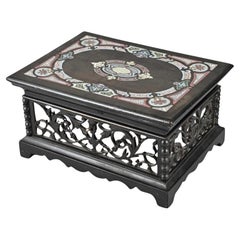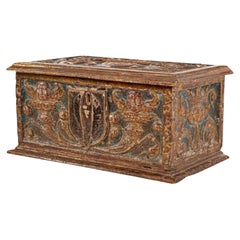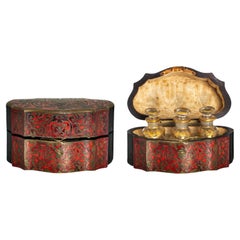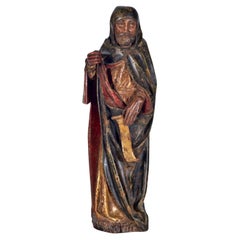Want more images or videos?
Request additional images or videos from the seller
1 of 7
Amazing French Document Casket / Box, 15th Century
$3,733.71List Price
About the Item
- Dimensions:Height: 5.12 in (13 cm)Width: 11.82 in (30 cm)Depth: 9.06 in (23 cm)
- Style:Gothic (Of the Period)
- Materials and Techniques:
- Place of Origin:
- Period:
- Date of Manufacture:15th Century
- Condition:Wear consistent with age and use. For the age it's in good condition, never hard restored.
- Seller Location:Madrid, ES
- Reference Number:1stDibs: LU5779232627152
About the Seller
4.8
Platinum Seller
Premium sellers with a 4.7+ rating and 24-hour response times
Established in 2005
1stDibs seller since 2021
376 sales on 1stDibs
Typical response time: 1 hour
Authenticity Guarantee
In the unlikely event there’s an issue with an item’s authenticity, contact us within 1 year for a full refund. DetailsMoney-Back Guarantee
If your item is not as described, is damaged in transit, or does not arrive, contact us within 7 days for a full refund. Details24-Hour Cancellation
You have a 24-hour grace period in which to reconsider your purchase, with no questions asked.Vetted Professional Sellers
Our world-class sellers must adhere to strict standards for service and quality, maintaining the integrity of our listings.Price-Match Guarantee
If you find that a seller listed the same item for a lower price elsewhere, we’ll match it.Trusted Global Delivery
Our best-in-class carrier network provides specialized shipping options worldwide, including custom delivery.You May Also Like
Very Rare Casket Minnekästchen or Box, Germany or Italy, 15th Century
Located in Beuzevillette, FR
Wooden coffret, call minnekästchen, engraved with a dog, a hare and foliage with
polychromy remains. During the Middle Age, the hare is a symbol of fertility, joy and represents the Christ...
Category
Antique 15th Century and Earlier European Gothic Decorative Boxes
Materials
Iron
$14,360
H 5.91 in W 12.6 in D 5.91 in
Embriachi workshop marquetry casket - Northern Italy, 15th century
Located in Bruxelles, BE
Embriachi workshop marquetry casket
Northern Italy, 15th century
Alla certosina inlays (bone, stained bone, pewter and wood)
H 28.2 x W 18 x D 14 cm
This beautiful casket of rectangular form is richly decorated with the characteristic geometric patterns of the Embriachi style.
The intricate geometric patterns are fashioned by juxtaposing lighter and darker pieces of wood, (colored) bone, horn and pewter. The lid and base are framed by a broad band of horn. When ivory became scarce in Europe due to disrupted trade routes, bone was substituted.
The attention to Symmetry and balance created an harmonious visual effect
Enhancing the overall aesthetic appeal of the casket.
The application of geometrical motifs is in Italy known as marquetry ‘alla Certosina’, named after the Certosina Church in Pavia with its famous altarpiece decorated in this way. This is ‘intarsia technique’, a term derived from the Arabic 'tarsi', which means ‘incrustation' recalling ancient mosaics made from various materials.
These geometric elements not only enhance the aesthetic appeal of the caskets but also demonstrate the versatility and skill of the artisans in creating multifaceted works of art.
‘Alla Certosina’ became famous through the Northern Italian Embriachi family who achieved a particularly high standard in working in this technique. Venice in particular was known for the production of these luxurious boxes. The caskets, hexagonal or rectangular, surmounted by a lid decorated in several registers constitute the secular, albeit equally renowned component of the workshop’s production, in addition to mirror frames and various everyday objects.
The method of fabrication of those objects was based on two concepts that underlay pre-industrial production: standardization and modularity, thanks to a distribution of skills according to the different phases of fabrication.
even the realization of the marquetry motifs (in the form of ingots from which portions of the desired size were cut) were therefore entrusted to various specialized craftsmen, as were the assembly phase.
Today better known thanks to the extensive research work recently carried out by Michele Tomasi, this workshop owes its name to its founder and owner, the Florentine Baldassare Ubriachi (or degli Embriachi), a merchant and banker established in the Tuscan capital before he settled in Venice in 1395. Together with sculptor Giovanni di Jacopo, who directed the workshop, from the last years of the fourteenth century, Baldassare oversaw a production that was truly original, and still easily recognizable today, comprising monumental altarpieces and various objects, primarily triptychs and caskets.
The precise location of the workshop is unknown, except that it originated in Florence and in ca. 1431 there was apparently a workshop in Venice, in the area of S Luca. They employed local workers specializing in 'certosina' (inlay of stained woods, bone and horn), and the workshop produced items carved in bone (usually horse or ox) with wood and bone marquetry.
The geometric decoration of Embriachi caskets reflects the artistic complexity and attention to detail that characterized their work.
this inlaid casket is a testament to the skill and artistry of the Embriachi family and serves as a stunning example of the decorative arts of the late Middle Ages.
Related Literature :
E. Berger, Prunk-Kassetten: Europäischen Meisterwerke aus acht Jahrhunderten / Ornamental Caskets...
Category
Antique 15th Century and Earlier Italian Renaissance Decorative Boxes
Materials
Pewter
$20,371 Sale Price
22% Off
Free Shipping
H 11.11 in W 7.09 in D 5.91 in
Antique Rare 15th Century Venetian Casket Former Dr. Albert Figdor Collection
Located in Doha, QA
This exceptional 15th-century Venetian painted casket is a rare example of early decorative art from the late Medieval to early Renaissance period in the Republic of Venice, Italy. H...
Category
Antique 15th Century and Earlier Italian Renaissance Decorative Boxes
Materials
Wood, Paint
$23,750
Free Shipping
H 5.91 in W 7.88 in D 5.12 in
Gothic Canopy, France, 15th Century
Located in Bruxelles, BE
Gothic canopy
France, 15th century
Alabaster, some traces of polychromy
33 x 23 x 20 cm
Provenance:
- Private collection Genève, Switzerland
...
Category
Antique 15th Century and Earlier French Gothic Figurative Sculptures
Materials
Alabaster
$23,934 Sale Price
20% Off
Free Shipping
H 13 in W 9.06 in D 11.03 in
Wooden casket with polychrome and gilded "pastiglia" relief decor, Italy 15th c.
Located in Gorssel, GE
A rare wooden casket with polychrome and gilded pastiglia relief, Italy, 15th century.
The box is adorned with four finely executed scenes from the life of an unknown martyr — beautifully preserved and remarkably vivid after centuries.
Dimensions: 15.5 × 10.4 × 9 cm
Provenance: Dutch private collection
In overall good condition for its age, with minor losses to the surface and possible retouching to the polychromy. The ball feet are likely later additions.
Pastiglia [paˈstiʎʎa], an Italian term meaning "pastework", is low relief decoration, normally modelled in gesso or white lead, applied to build up a surface that may then be gilded or painted, or left plain. The technique was used in a variety of ways in Italy during the Renaissance.
White lead pastiglia was a north Italian speciality, produced between about 1450 and 1550. Six workshops were identified by Patrick M. De Winter, although their location remains uncertain; the Workshop of the Love and Moral Themes, whose products seem the most numerous, was possibly at Ferrara, where the painter Cosimo Tura began his career gilding caskets. Venice is also thought to have produced them. Other workshops identified by De Winter include the "Workshop of the main Berlin casket" and "Workshop of the Cleveland Casket".
The subjects were typically classical, drawn from both mythology and Ancient Roman history (especially the early period covered by Livy), but biblical ones are also found. Compositions can often be shown to be borrowed from another medium, such as prints or bronze plaquettes...
Category
Antique 15th Century and Earlier Italian Renaissance Decorative Boxes
Materials
Gesso, Wood
$14,958
H 3.55 in W 6.11 in D 4.1 in
17th Century French Bagard Casket Box with Provenance
Located in Dallas, TX
An extraordinary carved wooden casket by César Bagard, ca. 1700–1720, created in the Lorraine region of France and attributed to the famed sculptor of Louis XIV. Rich with historical...
Category
Antique 1710s European Decorative Boxes
Materials
Wood
Document Box, Netherlands, Late 19th Century
Located in Milano, IT
Document box made of ebony veneered wood, the top contains a malachite plate with brass border with central emblem, malachite veneered feet. The plaque...
Category
Antique Late 19th Century Dutch Other Decorative Boxes
Materials
Malachite, Brass
Late 19th Century Bronze Jewel Casket Box
Located in Chapel Hill, NC
Late 19th century bronze jewel casket box, Egyptian. A Grand Tour souvenir. A Pharoh drives his chariot across the larger panels. End panels are opposing sphinxes. Unmarked. 3.25" x ...
Category
Antique Late 19th Century Egyptian Egyptian Jewelry Boxes
Materials
Bronze
19th Century Original Painted Dovetailed Document Box
Located in Los Angeles, CA
19th century original taupe painted dovetailed document box from New England. The original brass handled.
Category
Antique 19th Century American Country Decorative Boxes
Materials
Wood
Grand Scale, 18th Century, English Document Box
Located in Los Angeles, CA
An impressive, solid wood, period, hinge-top document box completely covered in tole and incised brass with delicate foliate designs throughout. The inside lined in a vibrant, scarle...
Category
Antique Mid-18th Century English Decorative Boxes
Materials
Metal, Brass
More From This Seller
View AllAmazing 19th Century French Lidded Box
Located in Madrid, ES
19th century French lidded box
with boulle-style inlay on lid (sawwork + mirrors).
Dimensions: 7 x 31 x 23 cm.
In good condition.
Category
Antique 19th Century French Baroque Decorative Boxes
Materials
Wood
Spanish Renaissance Casket of the 16th Century
Located in Madrid, ES
Spanish Renaissance casket,
16th century
In carved, polychrome and gilded wood decorated with a vase with horns of plenty, heads of cherubs and fruits.
In the lock a shield with two ...
Category
Antique 16th Century Dutch Baroque Decorative Boxes
Materials
Wood
PERFUME BOX WITH LID French Napoleon III 19th Century
Located in Madrid, ES
PERFUME BOX WITH LID
French Napoleon III 19th Century
in ebonised wood, tortoiseshell and gilded metal.
Interior with three golden glass bottles.
Defects of age
Dim.: (box) 11 x 1...
Category
Antique 19th Century French Napoleon III Decorative Boxes
Materials
Wood
San Antonio Abad, Spanish School of the 15th Century '1440-1501'
Located in Madrid, ES
San Antonio Abad, Castilian school of the 15th century (1440-1501)
Carving in polychrome wood, measures: 45 x 15 cm
good vintage conditions.
Category
Antique 15th Century and Earlier Spanish Gothic Figurative Sculptures
Materials
Wood
Rare 16th Century Nuremberg Box
Located in Madrid, ES
Rare 16th century Nuremberg box
In iron, measurements: 13 x 18 x 12 cm
Good condition.
Category
Antique 16th Century German Baroque Jewelry Boxes
Materials
Iron
Christ on the Cross – Late 15th Century, La Rioja (Spain)
Located in Madrid, ES
"Christ on the Cross – Late 15th Century, La Rioja (Spain)"
Important crucified Christ carved in polychrome wood, from the La Rioja region of Spain, and dating from the late 15th cen...
Category
Antique 15th Century and Earlier Spanish Gothic Religious Items
Materials
Wood
Recently Viewed
View AllMore Ways To Browse
Wooden Box French
Antique French Documents
Wood Casket
15th Century Wooden
Gothic Casket
15Th Century Casket
Gothic Casket Box
Antique Paper Mache Hand
Porcelain Box Germany
Brass Wood Box Italy
Italian Green Onyx
Lacquered Large Boxes
White Porcelain Boxes
Chinese Chinoiserie Box
Papier Mache Box
White Ceramic Box
Antique Cloisonne Boxes
Fish Box



